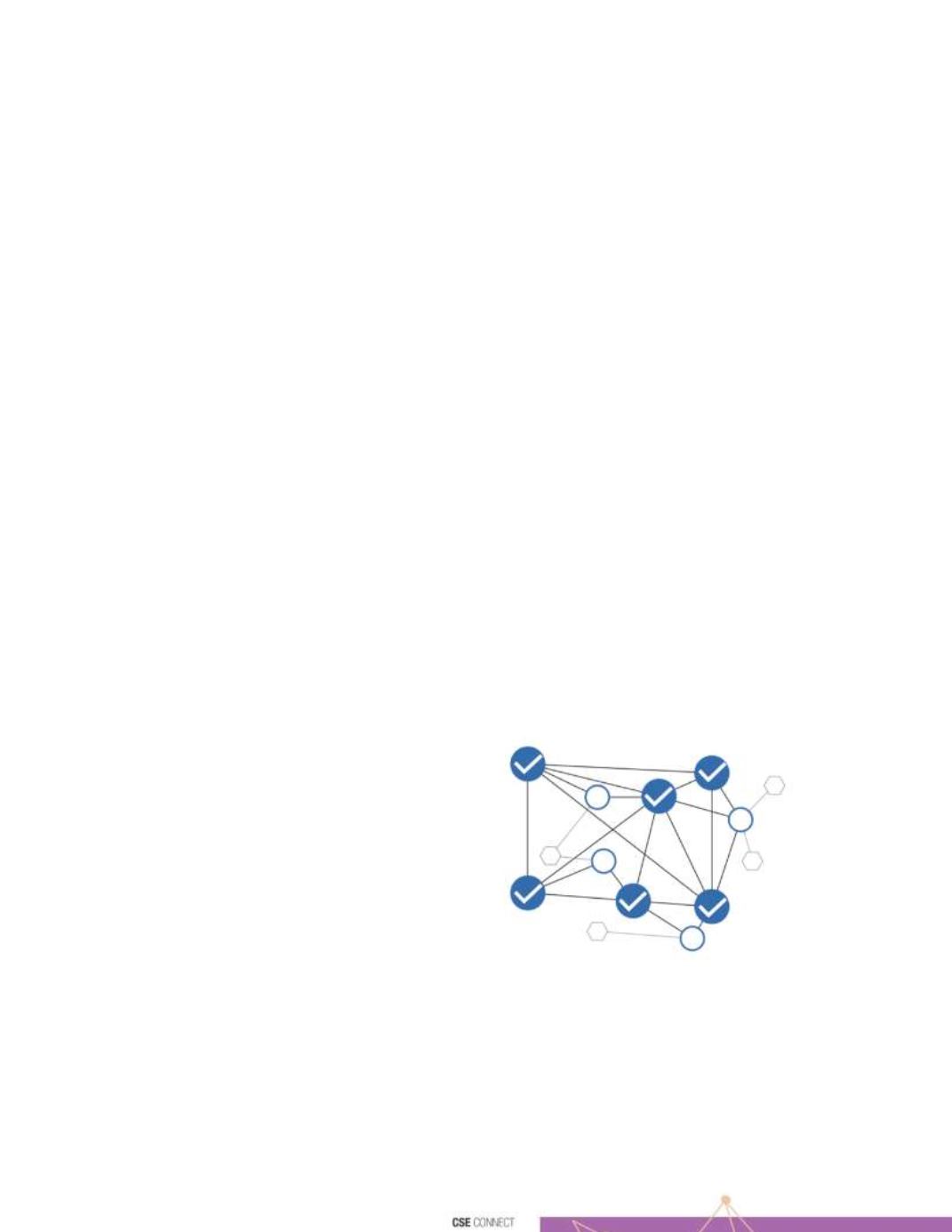

42
Each block in a blockchain consists of a block header and a
block body. Block header consists of the block version,
Merkle tree root hash, timestamp, n Bits, Nonce and Parent
block hash.
Transaction counter
and
transactions
are including in the block body. Block size and size of each
transaction determines a block’s maximum number
of transactions.
For validating
a transaction,blockchain uses asymmetric cryptography me
chanism.
Blockchain client that implement in smartphone can easily
verify
their
transaction
using Simple
Payment
Verification[SPV][1]. This lightweight client need only to
download the header of the blocks for verification of
transaction.
Characteristics of Blockchain
The main characteristics[2] of Blockchain are
Decentralization: In Blockchain there is no need for the third
party like centralized transaction system. So, it reduces the
cost
and
effort,
and
gives
better
performance. Consensus algorithms are uses in blockchain
for maintaining data consistency in distributed networks.
Persistency: If a node validates a transaction and put it in a
blockchain it is not possible to delete or rollback.
Honest miners never add invalid transaction in the block
and they quickly find out such false nodes.
Pseudonymity :For hiding personal information some of
them uses a nickname or false name or other entity name
for
establishing
relationship
with others.
This helps anonymity in some level of privacy, but it is not
fully anonymous.
Cryptographic hash function: Hash function takes any size
of input and give fixed length of output. It is
efficiently computable, irreversible,
collision resistance,
hiding and puzzle friendly.
Cryptographic guarantees: In Blockchain,
End users are signed all transaction. This transaction is
verified
by
user’s public key.
This signing guarantees the integrity, non- reputation and
authenticity.
Transparency: After verification of each transaction with
timestamp it includes in the distributed ledger.
Once transaction is recorded, it can verify any node and
data recorded in it and no one cannot delete or alter
the records.
Types of Blockchain
The types of blockchain are available in the market
are Permissioned(Private), Permissionless
(Public) and
consortium blockchain.
Permissionless(public) Blockchain
If anyone can read blockchain content or add nodes, this
type of blockchain is called public blockchain[1]. Bitcoin is
the publicly available blockchain and anyone can freely
download it and do mining problem. Ethereum
is another digital currency also permission less blockchain
and anyone can add smart contract to this network.
Permissioned (Private) Blockchain
In private blockchain, all users cannot freely join the network,
view the transaction history or issue their own transactions.
Centralized organizations are preferred this blockchain due
to the power of their own network for their own operations
within their network. In the private blockchain[1], only
authorized person has the permission to validating
transaction, issuing transaction, reading transaction history
or executing smart contract.
Governance, transparency, anonymity and
varying
decentralization are the features of the permissioned
blockchain. Blockstack and Multichain are examples of the
private blockchain.
Consortium Blockchain
Consortium
blockchain[1]
is
semi-decentralized,
controlled by group of authorized persons with permission
other
than
single
entity
and
consensus
process is handle a group
of pre-approved nodes
in
the network. Hyperledger, Corda an
d Quorumare example
of this network.
Using Anchoring in Blockchain technology block hashes of
private chain can write to public chain. This can help to
verify the transaction include in the ledger are validated and
it also strengthen the immutability.
Consensus Algorithms in Blockchain
Blockchain technology is distributed and there is no single
point of failure due to all nodes in the network have a copy
of blockchain structure. In this distributed nature, nodes
reach the agreement between each other by obtained by
use
of consensus
algorithm[1].
Proof of Work(PoW) is a trustless and distributed
consensus algorithm use in Bitcoin network and miners
need to solve cryptographic puzzles for getting rewards and
add new node in the blockchain. Proof
Delegated Stake(DPoS),Proof-of-Burn(PoB),Proof-of-Capacity(PoC),
Proof-of-Activity(PoA) etc. are other important consensus
algorithms uses in cryptocurrency.
















